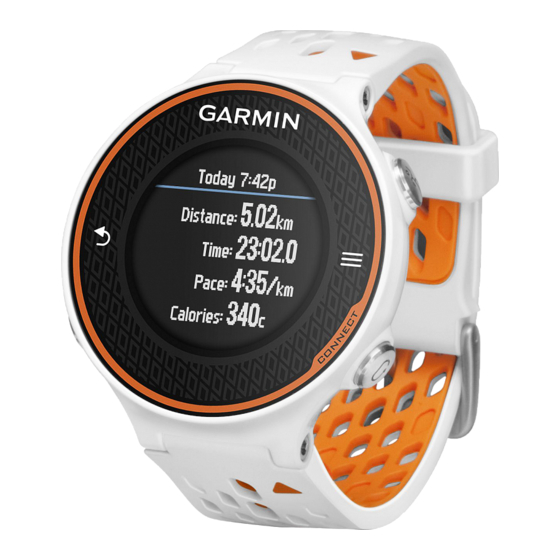Garmin Forerunner 620 Panduan Pemilik - Halaman 9
Jelajahi secara online atau unduh pdf Panduan Pemilik untuk Menonton Garmin Forerunner 620. Garmin Forerunner 620 18 halaman. Sports and fitness gps-devices
Juga untuk Garmin Forerunner 620: Panduan Cepat (25 halaman), Panduan Memulai Cepat (24 halaman)

Training with Running Dynamics
Before you can view running dynamics, you must put on the
HRM-Run accessory and pair it with your device
your Forerunner was packaged with the HRM-Run accessory,
the devices are already paired, and the Forerunner is set to
display running dynamics. You can put on your heart rate
monitor and skip to step 4.
1
Select
> Settings > Activity Settings > Data Screens >
Running Dynamics > Status > On.
2
Select Primary Metric.
3
Select Cadence, Ground Contact Time, or Vertical
Oscillation.
The primary metric appears as the top field on the data
screen with a corresponding position on the color gauge.
4
Go for a run.
Color Gauges and Running Dynamics Data
The running dynamics screen displays a color gauge for the primary metric. You can display cadence, vertical oscillation, or ground
contact time as the primary metric. The color gauge shows you how your running dynamics data compares to those of other
runners. The color zones are based on percentiles.
Garmin has researched many runners of all different levels. The data values in the red or orange zones are typical for less
experienced or slower runners. The data values in the green, blue, or purple zones are typical for more experienced or faster
runners. Less experienced runners tend to exhibit longer ground contact times, higher vertical oscillation, and lower cadence than
more experienced runners. However, taller runners typically have slightly slower cadences and slightly higher vertical oscillation. Go
to
www.garmin.com
for more information on running dynamics. For additional theories and interpretations of running dynamics data,
you can search reputable running publications and websites.
Color Zone
Percentile in Zone
Purple
>95
Blue
70–95
Green
30–69
Orange
5–29
Red
<5
Tips for Missing Running Dynamics Data
If running dynamics data does not appear, you can try these
tips.
• Make sure you have the HRM-Run accessory.
The HRM-Run accessory has
• Pair the HRM-Run accessory with your Forerunner again,
according to the instructions.
• If the running dynamics data display zeros, make sure the
HRM-Run module is worn right-side up.
NOTE: Ground contact time appears only while running. It
cannot be calculated while walking.
Tips for Erratic Heart Rate Data
If the heart rate data is erratic or does not appear, you can try
these tips.
• Reapply moisture to the electrodes and contact patch.
You can use water, saliva, or electrode gel.
• Tighten the strap on your chest.
• Warm up for 5–10 minutes.
• Wash the strap after every seven uses
• Wear a cotton shirt or wet your shirt if suitable for your
activity.
Synthetic fabrics that rub or flap against the heart rate
monitor can create static electricity that interferes with heart
rate signals.
• Move away from sources that can interfere with your heart
rate monitor.
Sources of interference may include strong electromagnetic
fields, some 2.4 Ghz wireless sensors, high-voltage power
lines, electric motors, ovens, microwave ovens, 2.4 Ghz
cordless phones, and wireless LAN access points.
• Replace the battery
(page
ANT+™ Sensors
(page
6). If
Cadence Range
>185 spm
174–185 spm
163–173 spm
151–162 spm
<151 spm
on the front of the module.
(page
9).
9).
5
Scroll to the running dynamics screen to view your metrics.
6
If necessary, hold the top field to change the primary metric
during your run.
Vertical Oscillation Range
<6.7 cm
6.7–8.3 cm
8.4–10.0 cm
10.1–11.8 cm
>11.8 cm
About VO2 Max. Estimates
You can use your Garmin device paired with the heart rate
monitor to display your VO2 max. estimate. VO2 max. is the
maximum volume of oxygen (in mililiters) you can consume per
minute per kilogram of body weight at your maximum
performance. In simple terms, VO2 max. is an indication of
athletic performance and should increase as your level of
fitness improves. VO2 max. estimates are provided and
supported by Firstbeat ® Technologies Ltd.
Getting Your VO2 Max. Estimate
Before you can view your VO2 max. estimate, you must put on
the heart rate monitor and pair it with your device
your Forerunner was packaged with a heart rate monitor, the
devices are already paired. For the most accurate estimate,
complete the user profile setup
maximum heart rate
NOTE: The projections may seem inaccurate at first. The
device requires a few runs to learn about your running
performance.
1
Run for at least ten minutes outdoors.
2
After your run, select Save.
3
Select
> VO2 Max..
Your VO2 max. estimate is a number and position on the
color gauge.
Ground Contact Time Range
<208 ms
208–240 ms
241–272 ms
273–305 ms
>305 ms
(page
7), and set your
(page
6).
(page
6). If
5
